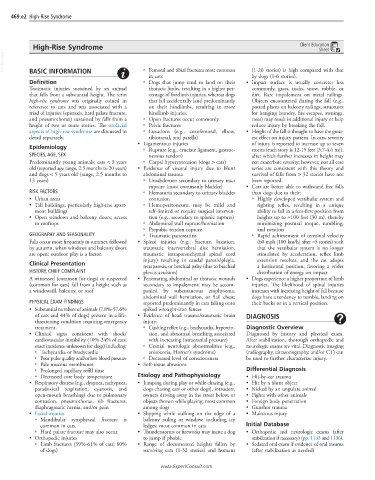Page 956 - Cote clinical veterinary advisor dogs and cats 4th
P. 956
469.e2 High-Rise Syndrome
High-Rise Syndrome Client Education
Sheet
VetBooks.ir
BASIC INFORMATION
○ Femoral and tibial fractures most common
by dogs (1-6 stories).
in cats (1-20 stories) is high compared with that
Definition ○ Dogs that jump tend to land on their • Impact surface is usually concrete; less
Traumatic injuries sustained by an animal thoracic limbs, resulting in a higher per- commonly, grass, rocks, snow, rubble, or
that falls from a substantial height. The term centage of forelimb injuries, whereas dogs dirt. Rare impalement on metal railings.
high-rise syndrome was originally coined in that fall accidentally land predominantly Objects encountered during the fall (e.g.,
reference to cats and was associated with a on their hindlimbs, resulting in more potted plants on balcony railings, structures
triad of injuries (epistaxis, hard palate fracture, hindlimb injuries. for hanging laundry, fire escapes, awnings,
and pneumothorax) sustained by falls from a ○ Open fractures occur commonly. trees) may result in additional injury or help
height of two or more stories. The orofacial ○ Pelvic fractures reduce injury by breaking the fall.
aspects of high-rise syndrome are discussed in ○ Luxations (e.g., coxofemoral, elbow, • Height of the fall is thought to have the great-
detail separately. tibiotarsal, and patella) est effect on injury pattern. In cats, severity
• Ligamentous injuries of injury is reported to increase up to seven
Epidemiology ○ Rupture (e.g., cruciate ligament, gastroc- stories (each story is 12-15 feet [3.7-4.6 m]),
SPECIES, AGE, SEX nemius tendon) after which further increases in height may
Predominantly young animals; cats < 3 years ○ Carpal hyperextension (dogs > cats) not exacerbate severity; however, not all case
old (reported age range, 2.5 months to 20 years) • Evidence of visceral injury due to blunt series are consistent with this theory and
and dogs < 5 years old (range, 2.5 months to abdominal trauma survival of falls from > 32 stories have not
13 years) ○ Uroabdomen secondary to urinary tract been reported.
rupture (most commonly bladder) • Cats are better able to withstand free falls
RISK FACTORS ○ Hematuria secondary to urinary bladder than dogs due to their:
• Urban areas contusion ○ Highly developed vestibular system and
• Tall buildings, particularly high-rise apart- ○ Hemoperitoneum: may be mild and righting reflex, resulting in a unique
ment buildings self-limited or require surgical interven- ability to fall in a feet-first position from
• Open windows and balcony doors; access tion (e.g., secondary to splenic rupture) heights up to ≈100 feet (30 m), thereby
to rooftops ○ Abdominal wall rupture/herniation minimizing postural torque, tumbling,
○ Prepubic tendon rupture and rotation
GEOGRAPHY AND SEASONALITY ○ Traumatic pancreatitis ○ Rapid achievement of terminal velocity
Falls occur more frequently in summer, followed • Spinal injuries (e.g., fracture, luxation, (60 mph [100 km/h] after ≈5 stories) such
by autumn, when windows and balcony doors traumatic intervertebral disc herniation, that the vestibular system is no longer
are open; outdoor play is a factor. traumatic intraparenchymal spinal cord stimulated by acceleration, reflex limb
injury) resulting in caudal paresis/plegia, extension resolves, and the cat adopts
Clinical Presentation tetraparesis, or brachial palsy (due to brachial a horizontal position, favoring a wider
HISTORY, CHIEF COMPLAINT plexus avulsion) distribution of energy on impact
A witnessed (common for dogs) or suspected • Penetrating abdominal or thoracic wounds • Dogs experience a higher proportion of limb
(common for cats) fall from a height such as secondary to impalement: may be accom- injuries. The likelihood of spinal injuries
a windowsill, balcony, or roof panied by subcutaneous emphysema, increases with increasing height of fall because
abdominal wall herniation, or flail chest; dogs have a tendency to tumble, landing on
PHYSICAL EXAM FINDINGS reported predominantly in cats falling onto their backs or in a vertical position.
• Substantial numbers of animals (7.8%-57.6% spiked wrought-iron fences
of cats and 44% of dogs) present in a life- • Evidence of head trauma/traumatic brain DIAGNOSIS
threatening condition requiring emergency injury:
treatment. ○ Cushing reflex (e.g., bradycardia, hyperten- Diagnostic Overview
• Clinical signs consistent with shock/ sion, and abnormal breathing associated Diagnosed by history and physical exam.
cardiovascular instability (10%-24% of cats; with increasing intracranial pressure) After stabilization, thorough orthopedic and
exact incidence unknown for dogs) including: ○ Cranial neurologic abnormalities (e.g., neurologic exams are vital. Diagnostic imaging
○ Tachycardia or bradycardia anisocoria, Horner’s syndrome) (radiography, ultrasonography, and/or CT) can
○ Poor pulse quality and/or low blood pressure ○ Decreased level of consciousness be used to further characterize injury.
○ Pale mucous membranes • Soft-tissue abrasions
○ Prolonged capillary refill time Differential Diagnosis
○ Decreased core body temperature Etiology and Pathophysiology • Hit-by-car trauma
• Respiratory distress (e.g., dyspnea, tachypnea, • Jumping during play or while chasing (e.g., • Hit by a blunt object
paradoxical respiration, cyanosis, and dogs chasing cats or other dogs), intruders, • Kicked by an ungulate animal
open-mouth breathing) due to pulmonary owners driving away in the street below, or • Fights with other animals
contusion, pneumothorax, rib fractures, objects thrown while playing; most common • Foreign body penetration
diaphragmatic hernia, and/or pain among dogs • Gunshot trauma
• Facial injuries • Slipping while walking on the edge of a • Malicious injury
○ Mandibular symphyseal fracture is balcony railing or window, including icy
common in cats. ledges; most common in cats Initial Database
○ Hard palate fracture may also occur. • Thunderstorms or fireworks may incite a dog • Orthopedic and neurologic exams (after
• Orthopedic injuries to jump if phobic stabilization if necessary) (pp. 1143 and 1136).
○ Limb fractures (39%-61% of cats; 80% • Range of documented heights fallen by • Sedated oral exam if evidence of oral trauma
of dogs) surviving cats (1-32 stories) and humans (after stabilization as needed)
www.ExpertConsult.com

